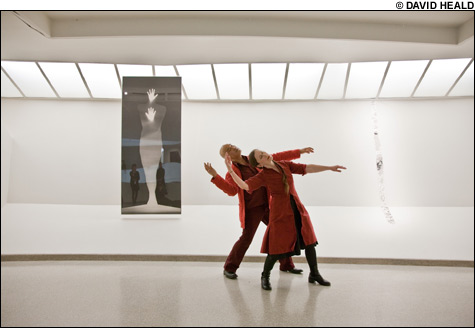
LIVING ON IN THE SPACE Ascension Variations at the Guggenheim March 5. |
NEW YORK — As the audience was making its way up the ramps of the Guggenheim Museum during the second part of Meredith Monk's Ascension Variations last Thursday night, we encountered a man in red curled up on his side on the floor, cradling a Jew's harp against his teeth. Later on in the massive dance-music event, Bohdan Hilash produced some very untraditional sounds from a sho, an instrument made of a bundle of upright bamboo flutes whose harmonica-like sounds accompany ancient Japanese court dances.
Ascension Variations was a new piece incorporating parts of an old piece, Juice, that Monk had created in 1969 for the Guggenheim. The red man with the Jew's harp was one of the retentions. From the primitive twanging and the comfortable utility of a metal bow you can put in your pocket to the intricately crafted sho, with its chordal resonances produced by the performer's breath, you could jump back and forth across centuries of musical history. The mix was seamless, and it spoke of Monk's consistent vision as well as her steady evolution. I experienced the whole evening in a dense, shifting envelope of time.
Juice was one of Monk's first large works, and — dancers had grandiose ambitions in those days — what went on in the Guggenheim was only one segment of a three-part project. She organized the same elements for a small theater and a tiny loft as well as for the vaulting, inverted snail-shell structure of Frank Lloyd Wright's modern art museum. To my amazed eyes and ears back then, it all seemed strange, harsh, deliberately rough-hewn.
Meredith Monk's work over the years has been unusually organic. The dancers have developed vocal skills, the singers can move. They all, even the instrumentalists, share a performing style of detached diligence and purity that allows their music and actions to carry information we all share, about experience and memory, work, love, nature. New elements gradually get absorbed and adapted to Monk's next film or recital or spectacle. Even the re-created parts of Juice seem a little smoother, more harmonious now.
Like Juice, Ascension Variations began with the audience seated at the bottom of the Guggenheim's five-story rotunda. There were clattering noises and then high, peeping voices calling across the space from nowhere, like birds waking up. A woman in gray (Ellen Fisher) appeared and began a slow, spiraling journey up the ramp.
More people and sounds materialized and dissolved. In addition to Monk's core ensemble (singers/dancers Fisher, Katie Geissinger, Ching Gonzalez, Bruce Rameker, Allison Sniffin, musicians Hilash and David Cossin, and Monk herself), there was a string quartet, four strangers in red, about 25 dancers, and two choruses — 120 performers altogether, according to the New York Times. Yet you never really saw any of them make an entrance. They just became a part of the space, hanging over or gliding along the concrete parapet, creating beautiful blocks of sound. I used to sing in a chorus with Katie Geissinger, and when I discovered her doing a phrase of thrusts and melodic shouts on the ramp, I longed to join her.